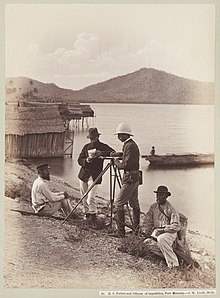Henry Ogg Forbes
Henry Ogg Forbes LLD (30 January 1851 – 27 October 1932) was a Scottish explorer, ornithologist, and botanist. He also described a new species of spider, Thomisus decipiens.[1]
Biography[]
Forbes was the son of Rev Alexander Forbes M.A. (1821–1897),[2] and his wife Mary née Ogg (1820–1862),[3] and was born at Drumblade, Huntly, Aberdeenshire.[3]
Henry was educated at Aberdeen Grammar School, he then studied Medicine at the University of Aberdeen and the University of Edinburgh,[4] An eye injury forced him to abandon his studies and he did not graduate. From 1875 he began collecting scientific samples: firstly in Portugal and from 1878 to 1884 he made extensive collections in Indonesia.[5]
Forbes was active primarily in the Moluccas, Sumatra and New Guinea. His unusual tasks there also included tracking down the murderers of Captain J. C. Craig on Joannet Island in his temporary capacity as a government agent. In 1887 he was appointed meteorological observer at Port Moresby in New Guinea and used this opportunity to attempt further exploration of the island interior. The map he made from these explorations was deemed "unreliable" and he was not paid for his efforts. Disgruntled he decided to return to Britain. However he made a major stay in New Zealand before achieving this.[5]

He served as Director of the Canterbury Museum in New Zealand between 1890 and 1893, and eventually moved to Liverpool, England, where he served as a consulting Director of Museums there until his death.[6]
Henry Ogg Forbes dedicated his book A Naturalist's Wanderings in the Eastern Archipelago to the zoologist William Alexander Forbes, who died on an expedition to West Africa in 1883. They had been friends and classmate at the University of Edinburgh.[7] Forbes is mentioned in A Short History of Nearly Everything by Bill Bryson.
He died in Selsey in Sussex on 27 October 1932.
Family[]
His older brother George Stuart Forbes (1849–1940) came to fame in the Indian Civil Service and was knighted for these services.[2]
Henry married in Batavia in 1882. Keith travelled extensively with her husband, assisting him with his collections and writing several books relating to their travels as well as contributing to scientific research, particularly on bird species.[8]
Legacy[]
Henry Ogg Forbes is commemorated in the scientific names of three species of reptiles: Hemidactylus forbesii, Oligodon forbesi, and Sphenomorphus forbesi.[9]
Gallery[]

Cucumber tree (Dendrosicyos socotranus) photograph by Forbes

Dragon's blood tree (Dracaena cinnabari ) photograph by Forbes

Frankincense and Adenium trees photograph by Forbes

Cattle in Socotra, based on a photograph by Henry Ogg Forbes published in The Natural History of Socotra and Abd-el-kuri

The guest house of the Sultan of Lahej, based on an 1898 photograph by Henry Ogg Forbes, from The Natural History of Socotra and Abd-el-kuri

View of Southern Face of Gebel Saleh, Abd al Kuri

View of the 'Strath' and Native Dwellings, Abd-el-Kuri
References[]
- ^ Forbes, H. O. (1883). "On the habits of Thomisus decipiens, a spider from Sumatra". Proceedings of the Zoological Society of London. 1883: 586–588.
- ^ Jump up to: a b Ewing, William Annals of the Free Church'
- ^ Jump up to: a b Mennell, Philip (1892). . The Dictionary of Australasian Biography. London: Hutchinson & Co – via Wikisource.
- ^ "FORBES, Dr. Henry Ogg". Who's Who. Vol. 59. 1907. p. 618.
- ^ Jump up to: a b Gibbney, H. J. Australian Dictionary of Biography. National Centre of Biography, Australian National University – via Australian Dictionary of Biography.
- ^ "obit. Dr. H. O. Forbes". Nature. 131 (3309): 460–461. 1 April 1933. doi:10.1038/131460a0. S2CID 37157315.
- ^ Forbes, Henry O. (1885). A Naturalist's Wanderings in the Eastern Archipelago: A Narrative of Travel and Exploration from 1878 to 1883. NY: Harpers & Brothers.
- ^ "In focus: Anna Forbes, Naturalist". National Museums Liverpool. Retrieved 1 March 2021.
- ^ Beolens, Bo; Watkins, Michael; Grayson, Michael (2011). The Eponym Dictionary of Reptiles. Baltimore: Johns Hopkins University Press. xiii + 296 pp. ISBN 978-1-4214-0135-5. ("Forbes, H. O.", pp. 91–92).
- ^ IPNI. H.O.Forbes.
External links[]
| Wikimedia Commons has media related to Henry Ogg Forbes. |
 Works written by or about Henry Ogg Forbes at Wikisource
Works written by or about Henry Ogg Forbes at Wikisource- Works by Henry Ogg Forbes at Project Gutenberg
- Works by or about Henry Ogg Forbes at Internet Archive
- Henry Ogg Forbes at Bright Sparcs
- 1851 births
- 1932 deaths
- People from Huntly
- Scottish explorers
- Scottish botanists
- Scottish ornithologists
- Alumni of the University of Aberdeen
- Alumni of the University of Edinburgh
- Directors of Canterbury Museum, Christchurch
- 20th-century British scientists
- 19th-century New Zealand scientists
- 19th-century British scientists
- People from Selsey
- Scottish biologist stubs
- British ornithologist stubs
- British explorer stubs
- Explorer stubs






